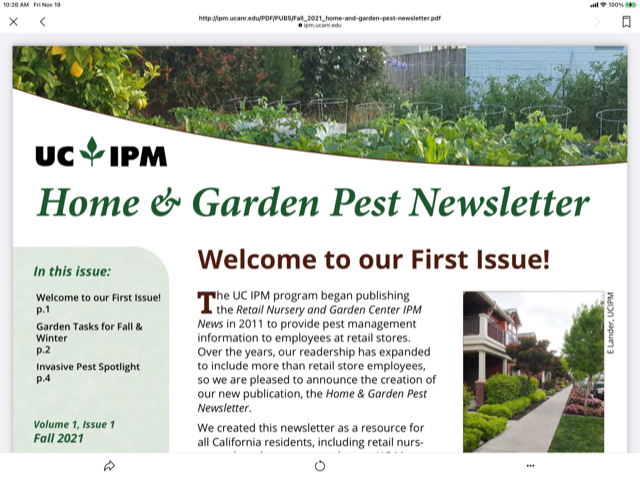
Resource for gardeners to be published three times annually

|
| This is a screen shot of the first page of the new e-newsletter from UC IPM. |
No gardener enjoys battling pests in spring. But there's a way to at least limit the damage: Do a thorough cleanup of the garden in fall and winter.
That's one of the messages in the new email newsletter from the University of California Integrated Pest Management program.
UC IPM is an invaluable resource for anyone who spends time with plants, from farmers to backyard gardeners. The program's experts, for example, track invasive pests that could ruin California's valuable agricultural output. On a smaller scale, they also recommend environmentally friendly methods of pest abatement so home gardeners can avoid using toxic chemicals.
All recommendations and information are solidly based on UC research. And pests, of course, aren't just insects but things such as weeds, invasive plants, diseases, birds, mammals and reptiles.
The newsletter will go out three times per year, produced by the Urban and Community IPM Team. Email signup is here.
Issue No. 1 includes an extensive list of garden tasks for fall and winter, starting with that all-important cleanup, but also pruning, planting, adjusting irrigation, monitoring for pests and lawn care.
The Invasive Pest Spotlight article focuses on the black fig fly, a new invasive species recently found in Southern California orchards.
The IPM program website, a veritable rabbit hole of pest information, is ipm.ucanr.edu .
-- Kathy Morrison
Comments
0 comments have been posted.Sacramento Digs Gardening to your inbox.
Food in My Back Yard Series
April 22: Should you stock up on fertilizer? (Yes!)
April 15: Grow culinary herbs in containers
April 8: When to plant summer vegetables
April 1: Don't be fooled by these garden myths
March 25: Fertilizer tips: How to 'feed' your vegetables for healthy growth
March 18: Time to give vegetable seedlings some more space
March 11: Ways to win the fight against weeds
March 4: Potatoes from the garden
Feb. 25: Plant a fruit tree now -- for later
Feb. 18: How to squeeze more food into less space
Feb. 11: When to plant? Consider staggering your transplants
Feb. 4: Starting in seed starting
Sites We Like
Garden Checklist for week of April 27
Once the clouds clear, get to work. Spring growth is in high gear.
* Set out tomato, pepper and eggplant transplants.
* From seed, plant beans, beets, cantaloupes, carrots, corn, cucumbers, melons, pumpkins, radishes and squash. Plant onion sets.
* In the flower garden, plant seeds for asters, cosmos, celosia, marigolds, salvia, sunflowers and zinnias. Transplant petunias, zinnias, geraniums and other summer bloomers.
* Plant perennials and dahlia tubers for summer bloom. Late April is about the last chance to plant summer bulbs, such as gladiolus and tuberous begonias.
* Transplant lettuce and cabbage seedlings.
* Weed, weed, weed! Don’t let unwanted plants go to seed.
* April is the last chance to plant citrus trees such as dwarf orange, lemon and kumquat. These trees also look good in landscaping and provide fresh fruit in winter.
* Feed citrus trees with a low dose of balanced fertilizer (such as 10-10-10) during bloom to help set fruit. Keep an eye out for ants.
* Apply slow-release fertilizer to the lawn.
* Thoroughly clean debris from the bottom of outdoor ponds or fountains.
* Start thinning fruit that's formed on apple and stone fruit trees -- you'll get larger fruit at harvest (and avoid limb breakage) if some is thinned now. The UC recommendation is to thin fruit when it is about 3/4 of an inch in diameter. Peaches and nectarines should be thinned to about 6 inches apart; smaller fruit such as plums and pluots can be about 4 inches apart. Apricots can be left at 3 inches apart. Apples and pears should be thinned to one fruit per cluster of flowers, 6 to 8 inches apart.
* Azaleas and camellias looking a little yellow? If leaves are turning yellow between the veins, give them a boost with chelated iron.
* Trim dead flowers but not leaves from spring-flowering bulbs such as daffodils and tulips. Those leaves gather energy to create next year's flowers. Also, give the bulbs a fertilizer boost after bloom.
* Pinch chrysanthemums back to 12 inches for fall flowers. Cut old stems to the ground.
* Mulch around plants to conserve moisture and control weeds.